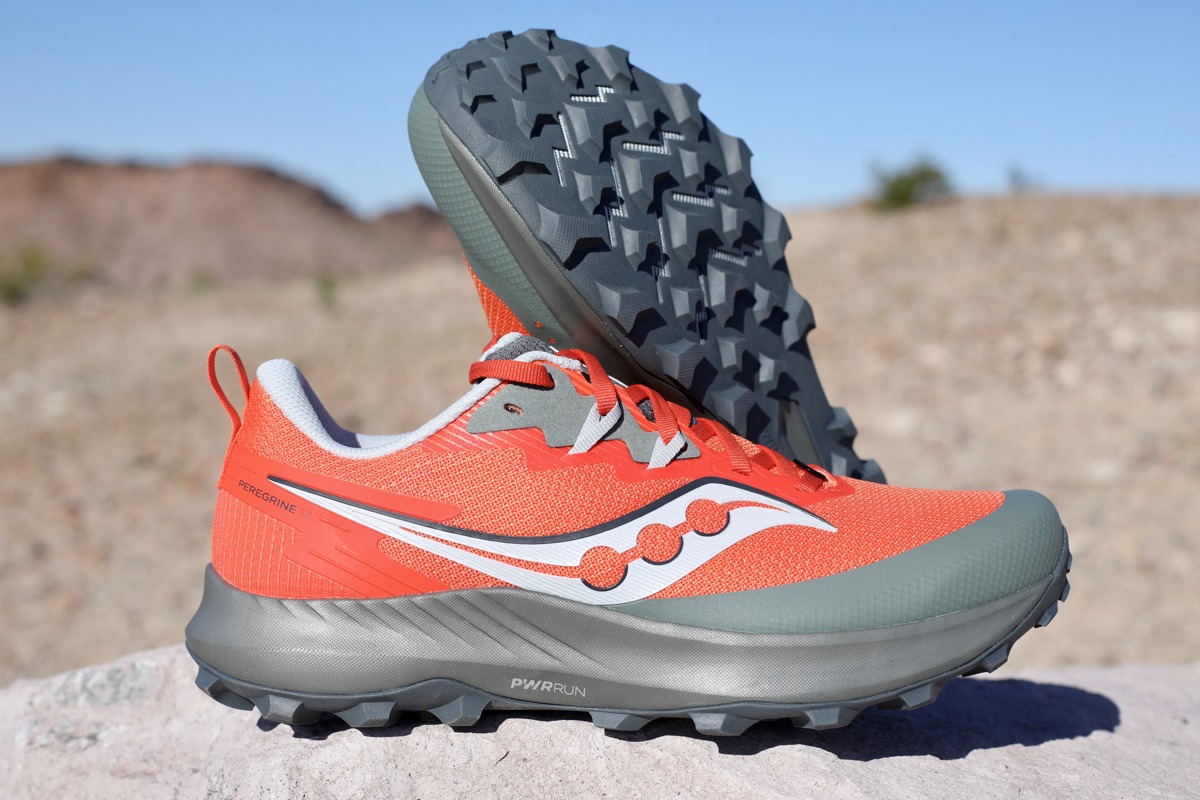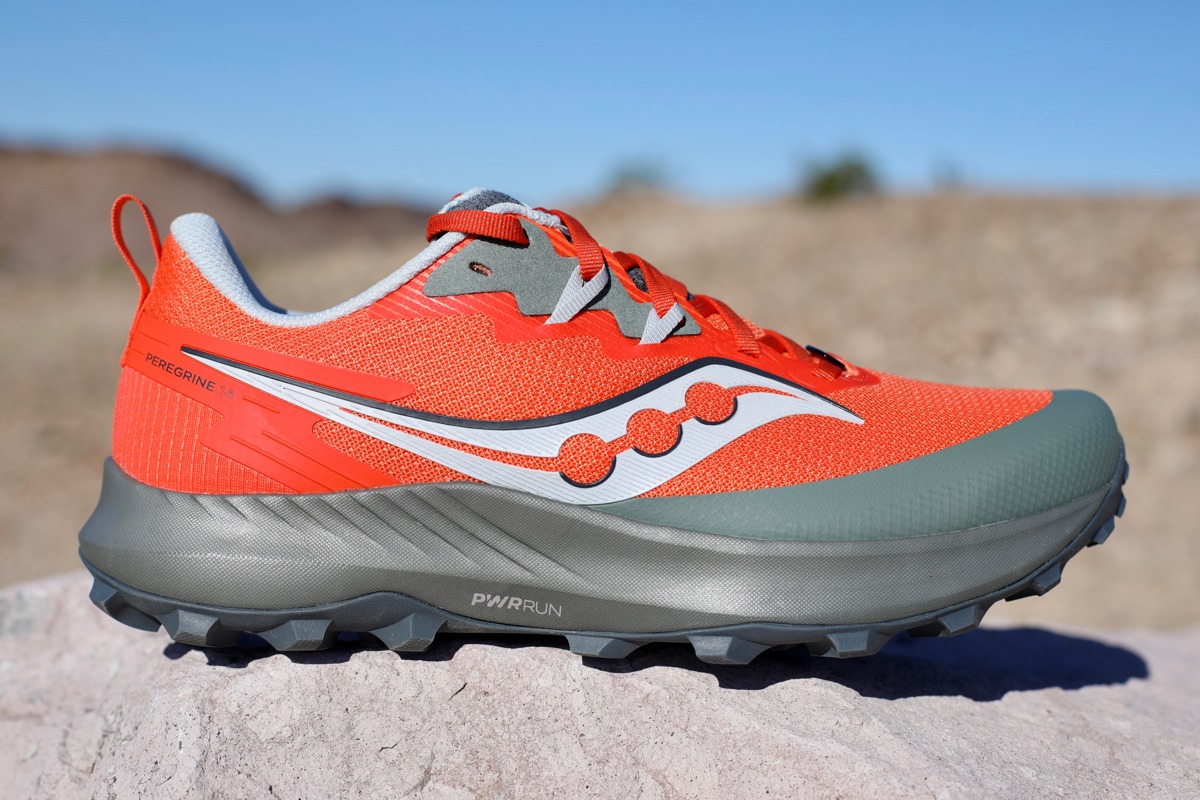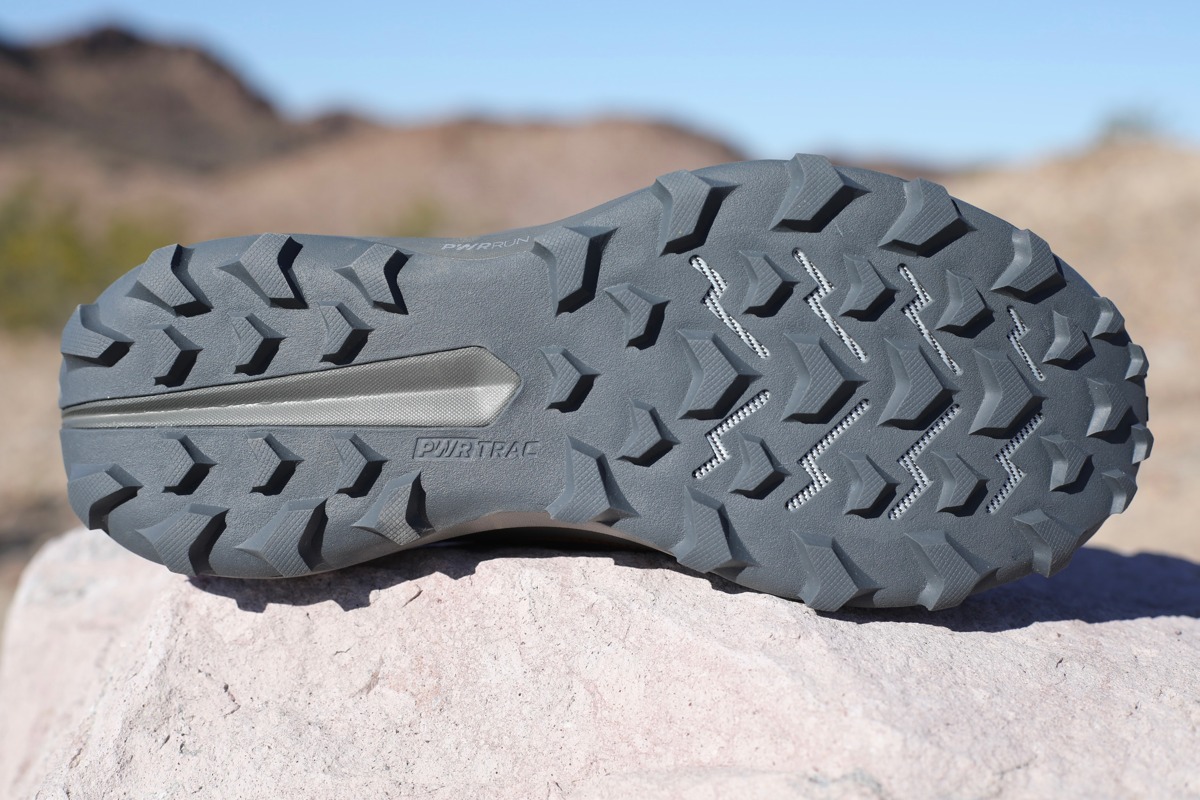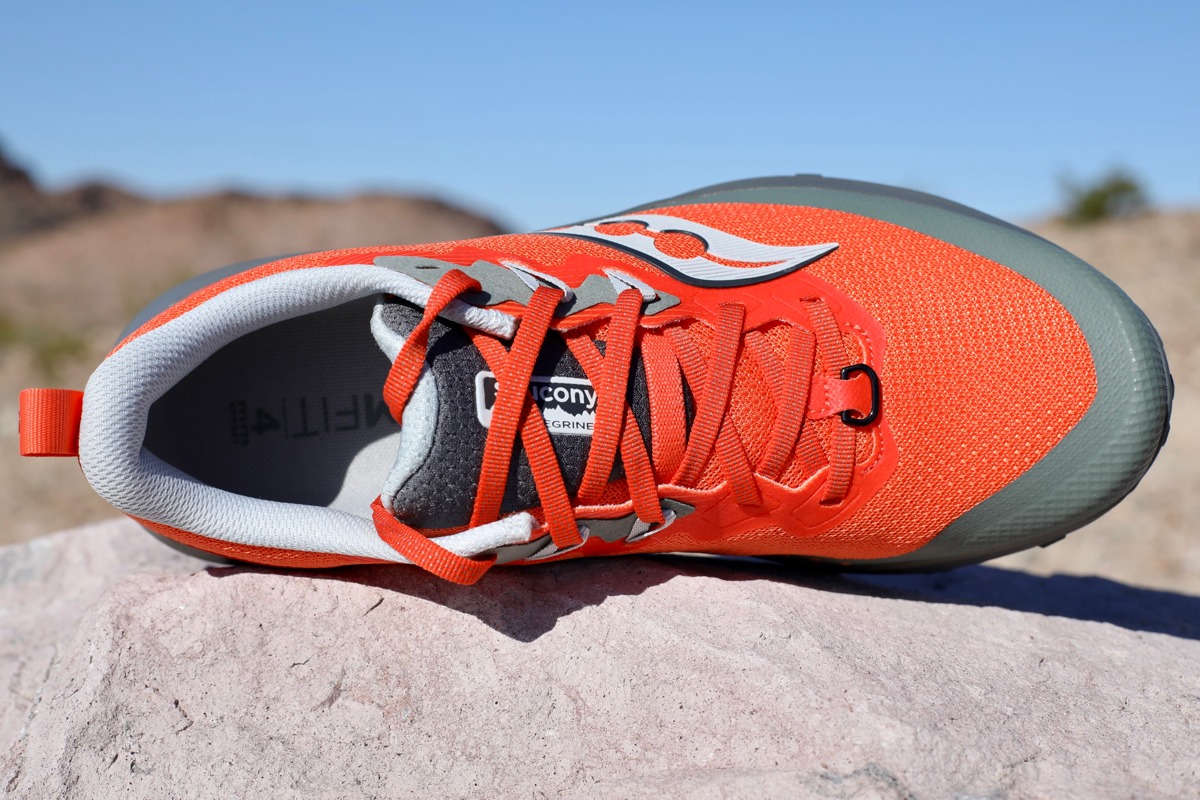For the latest on the Saucony Peregrine, check out our Saucony Peregrine 15 review.
Our Favorite Trail Running Shoes
Check out our Best Trail Running Shoes article to learn about our current favorite trail running shoes!
Saucony Peregrine 14 Review
The Saucony Peregrine 14 ($140) is an update on a classic shoe that has been a great all-arounder for a long time. With relatively deep 5-millimeter lugs, this shoe excels in dry conditions and holds its own when things get a little bit muddy and slick. The 28-millimeter and 24-millimeter heel and toe stack heights create a 4-millimeter drop, which is reasonable for a low-to-the-ground shoe.
The Saucony Peregrine 14 has an actual weight of 9.8 ounces (278 grams) for a U.S. men’s 9, making it light enough for some speed. The updated upper has a unique lacing system that provides a good level of lockdown, and Saucony has addressed some of the durability issues that plagued the previous version of this shoe.
Between its strong lineage and its most recent updates, the Peregrine 14 is a worthy inclusion in our Best Trail Running Shoes guide.
In this video review, iRunFar’s Travis Liles takes a deep dive into what has stayed the same and what has been updated in this classic and explains why it’s a great option as an all-arounder for anything from backyard training runs to 100-mile races.
Shop the Men's Saucony Peregrine 14Shop the Women's Saucony Peregrine 14
Saucony Peregrine 14 Review Transcript
Hey. Welcome to Trail Trials, the video review section of iRunFar. My name is Travis Liles, and in this video, we’re looking at a classic, the Saucony Peregrine 14. This is the 14th edition of this shoe. Let’s check it out.
All right, so let’s start off with the stats. This is the U.S. men’s size 9, which has an actual weight of 9.8 ounces. And a U.S. women’s 7 has a claimed weight right around 8.2 ounces. That is slightly up by a few decimal points from the last version. So, there’s a little more weight here. This is a 4-millimeter heel-to-toe drop. It has a luggy outsole. It’s meant to go fast. It’s meant to provide cushion. It’s meant to be a little bit more athletic.
So with all that, let’s see what’s new about this. Let’s see what’s the same about this. Let’s see how this shoe holds up all on its own.
Saucony Peregrine 14 Upper
Let’s start off with the upper of the Saucony Peregrine 14 here. It’s a very simple upper, for the most part. It is one kind of mesh, which is this standard mesh that’s been around for a while. It’s not that engineered mesh that’s kind of stretchy and flexible, which I don’t like for trail running shoes. I feel like it doesn’t hold my foot in place like I want it to, specifically on downhills, or over varied terrain where my foot’s moving around side to side. I don’t want a lot of give. I want a little bit more of a sticky feel where the shoe is not moving around underneath me. And I feel like this mesh does a pretty good job of that.
There are a couple of things I’ll point out here: some overlays. You can see a lot here around the toebox area. This toebox is a medium fit, so there is enough room for your toes to spread out a little bit. It’s not so narrow that everything is pinched in there to a point. I’d say this is more of a standard fit than it is a really fast, athletic fit. I think of some of the Salomon S/Lab models that are really, really narrow, even having a very narrow heel and underneath the arch, which is good for going fast and shorter distances.
This rides a nice line between enough width while being an athletic enough fit for longer distances, as well as shorter distances. It can work in a lot of scenarios. You’ve got a little bit of toe protection around here, this rubber cap here. It’s going to keep water from splashing in when you step in stuff, it’s going to add some durability, and it’s going to add a little bit of protection from kicking things.
There’s a little bit of doubled-up material inside of here. If you look at this flat, smooth, gray part that’s just on top of the mesh, once it turns into this little more patterned kind of thing, there’s some extra reinforcement. It is soft, still. It’s not super soft, but there’s just a small amount of rigidity. As you get closer to the actual toe of the shoe, you get a little more reinforcement coming from the outsole that wraps up in the toe cap area and this overlay.
This is a very standard lacing system. It’s not asymmetrical, it’s fairly straightforward. There’s a gaiter attachment here on the front but no Velcro in the back. And then the lacing: The interesting thing that I’ll call out here is these little extra eyelets. You can note here that just the standard eyelets are underneath. And then on top of those eyelets are these loose, free-hanging ones. If we open this up and look inside, we will see that those laces are connected down towards the midsole.
So, if you’re looking for some additional wrap and want to change the way that midfoot feels, you can just use the standard lacing and skip these guys altogether. Or you could skip that lacing and just use these. And because they’re a little looser, you can get a more interesting wrap between them. And because that’s down to the midsole, you can really get an even better grip on the top and sides of your foot. It’s just a nice way of choosing different options for your foot if the initial standard fit out of the box doesn’t work.
But overall, I think it’s a fairly good-fitting shoe, and I’d say it’s middling. It’s not hyper, hyper tight, but you have some options to lock it down and do well on downhills, uphills, and varied terrain. The lacing system works great for that.
On the tongue side, there is a gusset in here to keep debris out, which will take the entire distance of the lacing. This is all covered up with some straps underneath here that work to the midsole and give it a little bit of a sock-like feel inside the shoe.
From a heel standpoint, it’s a pretty standard fit. It’s got some rigidity in the back so it’s not fully collapsible. But it is mostly padded. It’s not overly padded, just medium padding. And they’ve even added a little reflector here for anybody that wears these shoes for road running, which I did, and they work just fine.
The one thing I’ll just call out here is this update: One of my problems with the last version was there was a lot of this rubber overlay stuff that added some weird seams and started splitting and peeling off. This is an example of the last version. You can see here, there are some of these pinch points where the shoe is starting to fray. There’s another side over here where this rubber was starting to come off [in the Peregrine 13]. And that’s not happening here [in the Peregrine 14].
This shoe has about 100 miles on it, and that other shoe started showing signs of that breakdown around that same mark. This one doesn’t show any of that. At least at this point, it’s more durable, which is always welcome.
Saucony Peregrine 14 Midsole
Let’s talk about the midsole here.
This Saucony Peregrine 14 has PWRRUN for the midsole, which is a little bit more of a standard type of foam. Basic cushioning. I’d say it’s fairly bouncy and rubbery. But for the most part, this is a more basic, middle, not-too-squishy, not-too-firm type of foam. And that’s all the way around the shoe.
I’ve always liked this foam. I think it does a good job and does really well for trail running shoes because it’s got enough rigidity that adds some snappiness, but it also has enough cushion that it doesn’t feel like it’s a beating to wear it over long, extended periods of time.
What’s interesting, and again, I’ve called out before, is that this shoe’s sock liner/insole actually uses a different type of foam. And you can see that really visibly here by this styrofoam-y look. This is called PWRRUN+. In Saucony’s more high-end shoes, or some of their road running shoes, they actually use this foam, which is more bouncy and has more rebound. I like this because it is a nice-feeling sock liner. It’s a little bit thicker, so it removes that problem where sometimes thin sock liners ball up or roll around. This one’s thick.
The other part that’s interesting is that because this is made out of midsole foam versus something standard, it doesn’t have all that pitting. As I mentioned before, I’ve got about 100 miles on these, and there are no spots where my toes have really pressed into this. This part of the shoe is a nice compromise. Instead of putting higher-end foam here and making the shoe potentially more expensive, or maybe making the feel different, they’ve put a little bit of investment into the sock liner and added more interesting foam.
It’s more bouncy, and there is more rebound foam here, which makes it a little more comfortable. I think it adds a little characteristic here that we would love to see on other shoes.
Saucony Peregrine 14 Outsole
Rolling over to the outsole, the Peregrine model has always been known for this: big, toothy lugs. The same thing exists here on the outside of the shoe: downward-facing lugs for traction, braking downhill, and these other ones for climbing, so these various types of lugs are going multi-directions for traction in multiple ways. And they’re fairly deep. These are 5-millimeter lugs, so they grip well pretty much in any environment. They’re not the stickiest, so sometimes on marble-y wet ground or a wet wooden bridge with a little bit of moss or sort of organic matter on the top of it, they can slide around a lot. It’s not terrible, but it’s not the stickiest.
So, good lug depth. It’s above average on the dry and wet traction side of the house. It’s just some of those most sticky or slick environments where you’ll probably not get much traction. But again, that’s a very specialized shoe that tends to work there.
And then to the rock plate’s side of the house. It’s not a standard plastic one. It’s sort of this fabric-y one. If you get one of these in hand, you can feel it: It’s knitted. It’s some sort of densely woven, tight fabric that adds protection here in the midfoot. For the most part, I have not really noticed a lot poking through in these areas.
The middle of the shoe, the back of the heel, those types of areas, yes. There is no rock plate once you get past the front part of the foot, or all the way back. Most of the time, you’re sacrificing a little bit of flexibility, and a little bit of speed, and it feels like a more rigid shoe when that rock plate extends all the way. This is a nice compromise and keeps the shoe mostly lightweight. It’s not as hard and plasticky as some of those others, so it still creates some flexibility while having protection.
Saucony Peregrine 14 Overall Impressions
In closing, I think the Saucony Peregrine 14 got its footing again. And I don’t mean that as a joke with the grip, but I guess that works.
This shoe started out long ago as lightweight, low-to-the-ground, grippy, protective, all-arounder that you could do a lot in while maintaining some speed. I’ve done a 100 miler in a pair of Peregrines, multiple 100 milers. It’s a shoe that I feel comfortable talking about, and that I’ve had a lot of lineage in.
There have been some bad versions of this shoe. The last version was pretty good but had some durability issues. So far, with where this one is at compared to version 13, a lot of that has been updated and changed, and I don’t see any of that fraying, splitting, or this overlay stuff peeling off. So that’s all really positive.
I think the fit and the feel cover a lot of different scenarios. If you want to go fast, this is an athletic enough fit to do that. And it’s mostly lightweight. While 9.8 ounces isn’t super light, you can definitely do some turnover. It’s got that light, short, stack on it, so you’re not tipsy and up high. It has enough cushion where that 4-millimeter drop doesn’t feel like it’s too much, like it’s too aggressive, which can happen in shoes that are lower with less cushion.
It’s a really great sock liner that I liked before, and I like now.
From versions 13 to 14, this is absolutely just a very small iteration. I’d say it’s mainly tweaks to the upper. Everything else feels the same. The protection, the fit, the traction, the rock plate are all the same. You’re really getting a slightly more durable, and I say slightly because I just don’t have enough miles on this to say overly durable, but I do know that with over 100 miles on this shoe, it is holding up significantly better. This shoe is worthy of its placement in our Best Trail Running Shoes guide.
If you’re looking for something that can do it all, and you’re looking for it in a 2024 price range that’s closer to $100 than $200, I think this is a really great option to go for, and one that I really add into the mix quite a bit. Anytime it’s muddy and mucky, this tends to be one of the first types of shoes that I grab.
Any questions, or comments, leave those below the video. Thanks for watching. We’ll catch you next time.
Shop the Men's Saucony Peregrine 14Shop the Women's Saucony Peregrine 14
Call for Comments
- Have you tried out any of the Peregrine line of shoes? Have you run in the Saucony Peregrine 14?
- Do you have a favorite everyday trail shoe?
Our Favorite Trail Running Shoes
Check out our Best Trail Running Shoes article to learn about our current favorite trail running shoes!





